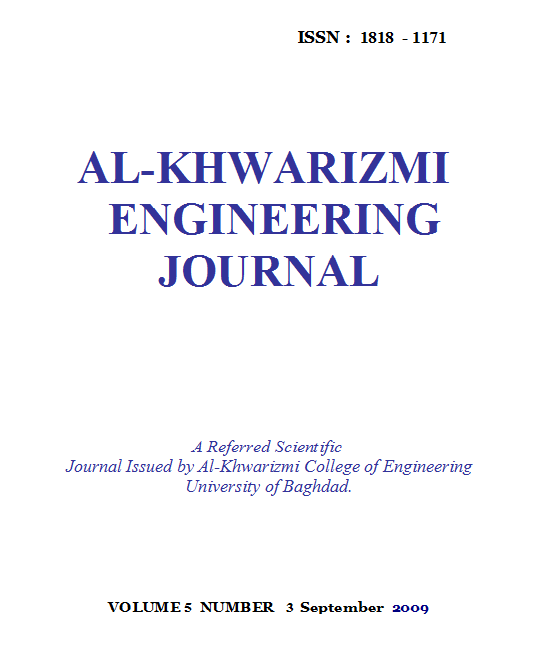Time Prediction of Dynamic Behavior of Glass Fiber Reinforced Polyester Composites Subjected to Fluctuating Varied Temperatures
Abstract
The reduction of vibration properties for composite material (woven roving E-glass fiber plies in thermosetting polyester matrix) is investigated at the prediction time under varied combined temperatures (60 to -15) using three types of boundary conditions like (CFCF, CCCF, and CFCC). The vibration properties are the amplitude, natural frequency, dynamic elastic moduli (young modulus in x, y directions and shear modulus in 1, 2 plane) and damping factor. The natural frequency of a system is a function of its elastic properties, dimensions, and mass. The woven roving glass fiber has been especially engineered for polymer reinforcement; but the unsaturated thermosetting polyester is widely used, offering a good balance of vibration properties at moderate or ambient temperatures, and also at relatively low cost. The mismatch between matrix and fiber yarns gives a predominant role for the fiber's mechanics where the matrix is the area where most damage mechanisms develop. The free vibration test was carried out for (5, 10, 15, 20, 25, 30) minutes. The composite plate was exposed to (75) of thermal gradient for ten times in various times at different stages. The results were classified into experimental and finite element using software ANSYS Ver. 9.
Downloads
References
[2] HACENE BOUADI. C. T. SUN, "Hygrothermal Effects on Structural Stiffness and Structural Damping of Laminated Composites", Journal of Materials Science, Vol. 25, No. 1, p.p. 499-505, 1990.
[3] P.K. PARHI, S.K. BHATTACHARYYA, and P.K. SINHA, "Hygrothermal Effects on the Dynamic Behavior of Multiple Delaminated Composite Plates and Shells", Journal of Sound and Vibration, Science Direct, Vol. 248, Issue 2, p.p. 195-214, 22 November, 2001.
[4] Xinyun Guo, Adam Przekop, and Chuh Mei, "Reduction of Random Response of Composite Plates Using Shape Memory Alloy in Thermal Environments", Journal of Structural Dynamics & Materials Conference, 19-22 April, 2004.
[5] Praveen Kumar Kavipurapu, "Forced Vibration and Hygrothermal Analysis of Composite Laminated Beams under the Action of Moving Loads", University Of West Virginia, Department of Mechanical and Aerospace Engineering, M.Sc. Thesis, 2005.
[6] Mehmet C¸OLAKO˘GLU, "Damping and Vibration Analysis of Polyethylene Fiber Composite under Varied Temperature", Turkish J. Eng. Env. Sci., Vol. 30, p.p. 351-357, 2006.
[7] Shi-Rong Li, R. C. Batra, and Lian-Sheng Ma, "Vibration of Thermally Post-Buckled Orthotropic Circular Plates", Journal of Thermal Stresses, Vol. 30, p.p. 43-57, 2007.
[8] Ramadan J. Mustafa, "Temperature Dependence of Dynamic Modulus and Damping in Continuous Fiber- Reinforced Al-(alloy) Matrix Composites at Elevated Temperatures", Jordan Journal of Mechanical and Industrial Engineering, Vol. 2, No. 1, p.p. 15-21, March, 2008.
[9] Kleinholz R., and Molinier G.," Aramid Carbon and Glass Fiber Specialized Reinforcement Materials for Composites", Vetrotex Fiber World, No. 22, p.p. 13, 1986.
[10] B.C. Ray, “ Thermal Shock and Thermal Fatigue on Delamination of Glass Fiber Reinforced Polymeric Composites”, Journal of Reinforced Plastics and Composites, Vol.24,No. 1, 2005.
[11] WILLIAM.T. THOMSON, “Theory of Vibration with Applications”, Second Edition, Englewood Cliffs, New Jersey, 1981.
[12] Robert M. Jones," Mechanics of Composite Materials", McGraw-Hill Book Company, 1975.
Downloads
Published
Issue
Section
License
Copyright: Open Access authors retain the copyrights of their papers, and all open access articles are distributed under the terms of the Creative Commons Attribution License, which permits unrestricted use, distribution, and reproduction in any medium, provided that the original work is properly cited. The use of general descriptive names, trade names, trademarks, and so forth in this publication, even if not specifically identified, does not imply that these names are not protected by the relevant laws and regulations. While the advice and information in this journal are believed to be true and accurate on the date of its going to press, neither the authors, the editors, nor the publisher can accept any legal responsibility for any errors or omissions that may be made. The publisher makes no warranty, express or implied, with respect to the material contained herein.












